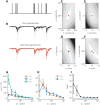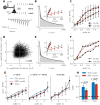Linear-nonlinear cascades capture synaptic dynamics
- PMID: 33720935
- PMCID: PMC7993773
- DOI: 10.1371/journal.pcbi.1008013
Linear-nonlinear cascades capture synaptic dynamics
Abstract
Short-term synaptic dynamics differ markedly across connections and strongly regulate how action potentials communicate information. To model the range of synaptic dynamics observed in experiments, we have developed a flexible mathematical framework based on a linear-nonlinear operation. This model can capture various experimentally observed features of synaptic dynamics and different types of heteroskedasticity. Despite its conceptual simplicity, we show that it is more adaptable than previous models. Combined with a standard maximum likelihood approach, synaptic dynamics can be accurately and efficiently characterized using naturalistic stimulation patterns. These results make explicit that synaptic processing bears algorithmic similarities with information processing in convolutional neural networks.
Conflict of interest statement
The authors have declared that no competing interests exist.
Figures









Similar articles
-
Synaptic dynamics: linear model and adaptation algorithm.Neural Netw. 2014 Aug;56:49-68. doi: 10.1016/j.neunet.2014.04.001. Epub 2014 Apr 28. Neural Netw. 2014. PMID: 24867390
-
Optimality model of unsupervised spike-timing-dependent plasticity: synaptic memory and weight distribution.Neural Comput. 2007 Mar;19(3):639-71. doi: 10.1162/neco.2007.19.3.639. Neural Comput. 2007. PMID: 17298228
-
Correlation entropy of synaptic input-output dynamics.Phys Rev E Stat Nonlin Soft Matter Phys. 2006 Oct;74(4 Pt 1):041909. doi: 10.1103/PhysRevE.74.041909. Epub 2006 Oct 9. Phys Rev E Stat Nonlin Soft Matter Phys. 2006. PMID: 17155098
-
Propagation delays determine neuronal activity and synaptic connectivity patterns emerging in plastic neuronal networks.Chaos. 2018 Oct;28(10):106308. doi: 10.1063/1.5037309. Chaos. 2018. PMID: 30384625 Review.
-
Synaptic plasticity: taming the beast.Nat Neurosci. 2000 Nov;3 Suppl:1178-83. doi: 10.1038/81453. Nat Neurosci. 2000. PMID: 11127835 Review.
Cited by
-
Computational protocol for modeling and analyzing synaptic dynamics using SRPlasticity.STAR Protoc. 2025 Mar 21;6(1):103652. doi: 10.1016/j.xpro.2025.103652. Epub 2025 Mar 2. STAR Protoc. 2025. PMID: 40029747 Free PMC article.
-
Power-law adaptation in the presynaptic vesicle cycle.Commun Biol. 2025 Apr 2;8(1):542. doi: 10.1038/s42003-025-07956-6. Commun Biol. 2025. PMID: 40175679 Free PMC article.
-
Grid cells, border cells, and discrete complex analysis.Front Comput Neurosci. 2023 Oct 10;17:1242300. doi: 10.3389/fncom.2023.1242300. eCollection 2023. Front Comput Neurosci. 2023. PMID: 37881247 Free PMC article.
-
Nonlinear recurrent inhibition through facilitating serotonin release in the raphe.Nat Neurosci. 2025 May;28(5):1024-1037. doi: 10.1038/s41593-025-01912-7. Epub 2025 Apr 2. Nat Neurosci. 2025. PMID: 40175691
-
Optimizing interneuron circuits for compartment-specific feedback inhibition.PLoS Comput Biol. 2022 Apr 28;18(4):e1009933. doi: 10.1371/journal.pcbi.1009933. eCollection 2022 Apr. PLoS Comput Biol. 2022. PMID: 35482670 Free PMC article.
References
-
- Feng T. Studies on the neuromuscular junction. XXVI. The changes of the end-plate potential during and after prolonged stimulation. Chinese Journal of Physiology. 1941;16:341–372.
-
- Eccles JC, Katz B, Kuffler SW. Nature of the “endplate potential” in curarized muscle. Journal of Neurophysiology. 1941;4(5):362–387. 10.1152/jn.1941.4.5.362 - DOI
Publication types
MeSH terms
Grants and funding
LinkOut - more resources
Full Text Sources
Other Literature Sources

